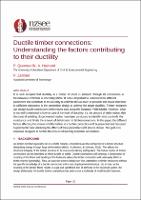| dc.contributor.author | Quenneville, Pierre | |
| dc.contributor.author | Hashemi, Ashkan | |
| dc.contributor.author | Zarnani, Pouyan | |
| dc.date.accessioned | 2023-02-21T01:18:11Z | |
| dc.date.available | 2023-02-21T01:18:11Z | |
| dc.date.issued | 2022-04-27 | |
| dc.identifier.uri | https://repo.nzsee.org.nz/xmlui/handle/nzsee/2475 | |
| dc.description.abstract | It is well accepted that ductility in a timber structure is achieved through its conections as the behaviour of timber is inherently brittle. It is thus important to understand the diferent parameters that contribute to the ductility in order to optimise this as much as possible and ensure that there is sufficient robustness in the connection design to achieve the expected ductility. Timber designers can design ductile connections with relative ease using the European Yield Model. However, what is not well understood is how to control the level of ductility, i.e.the amount of deformation after the onset of yielding. An experimental study has been conducted to identify what limits the amount of deformation in a typical bolted timber connection. In this presentation, the different factors affecting the amount of deformation in a ductile connection will be presented and discussed. Experimental data validating the effects of these parameters will be also be shown. The goal is to empower designers to control the amount of ductility in timber connections. | |
| dc.language.iso | en | |
| dc.publisher | New Zealand Society for Earthquake Engineering | |
| dc.relation.ispartofseries | 2022;30 | |
| dc.subject | Quantifying and addressing uncertainties in seismic design | |
| dc.subject | Case studies of achieving building resilience while accounting for uncertainties | |
| dc.subject | Case studies or research of integrating sustainable engineering | |
| dc.title | Ductile timber connections: Understanding the factors contributing to their ductility | |
| dc.type | Article | |

